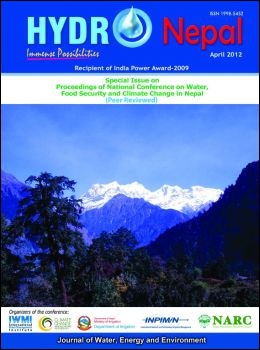Enhancing Water Productivity for Agriculture and Adapting to Climate Change in Food Insecure Areas - Practical Experiences from Far and Mid West Nepal
DOI:
https://doi.org/10.3126/hn.v11i1.7205Keywords:
Water Use Master Plan, Far and Mid Western Nepal, climate change adaptation, food security, NepalAbstract
The Rural Village Water Resources Management Project Phase II (RVWRMP-II) works in some of the most remote, food insecure and water scarce areas of Nepal, where the impacts and effects of climate change are already visible. The farmers of the project region are dependent on rain-fed agriculture. Large parts of the project area (parts of Humla and Bajura Districts, for instance) depend on food aid.
In Phase II, specific attention is being paid to climate change adaptation, efficient use of water for agriculture, and food security and nutrition.
RVWRMP facilitates communities to design and implement Water Use Master Plans (WUMP). One of the objectives of a WUMP is to optimize the use of water for agriculture. Micro-irrigation, rain water harvesting, multi-use schemes, using drainage water from tap stands for home gardens and organic fertilizers are some of the ways to improve the food security in the communities. Water source protection, watershed conservation, soil protection and crop selection are key technical areas of interest to enable adaptation to the anticipated changes in climate.
DOI: http://dx.doi.org/10.3126/hn.v11i1.7205
Hydro Nepal Special Issue: Conference Proceedings 2012 pp.54-58
Downloads
Downloads
Published
How to Cite
Issue
Section
License
The copyright of the articles and papers published is held by HYDRO Nepal Journal.
The views and interpretation in this journal are those of author(s), and HYDRO Nepal does not bear any responsibility for the views expressed by authors in the journal.




